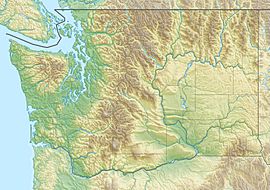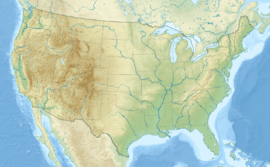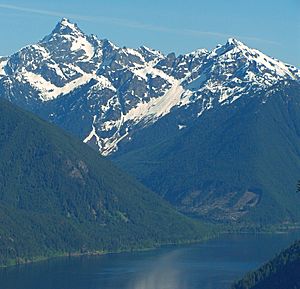Nodoubt Peak facts for kids
Quick facts for kids Nodoubt Peak |
|
|---|---|

Nodoubt Peak seen from Copper Ridge
|
|
| Highest point | |
| Elevation | 7,290 ft (2,220 m) |
| Prominence | 1,250 ft (380 m) |
| Isolation | 1.43 mi (2.30 km) |
| Geography | |
| Location | North Cascades National Park Whatcom County, Washington, U.S. |
| Parent range | Skagit Range North Cascades Cascade Range |
| Topo map | USGS Mount Redoubt |
| Geology | |
| Age of rock | 26 to 29 million years |
| Type of rock | Skagit gneiss and granodiorite |
| Climbing | |
| First ascent | 1859 by Francis Herbst |
Nodoubt Peak is a tall mountain in the Skagit Range of the North Cascades in Washington state. It stands about 7,290-foot (2,220-metre) high. This peak is located inside North Cascades National Park, not far from the border with Canada. Its closest taller neighbor is Canuck Peak, about 1.43 mi (2.30 km) away. Mount Redoubt is also nearby, about 3.04 mi (4.89 km) to the southeast.
Nodoubt Peak got its name from a group of geologists who climbed it in 1967. Its name is a fun word play on Mount Redoubt's name. Water from Nodoubt Peak flows into streams that feed the Chilliwack River.
Contents
Weather and Climate at Nodoubt Peak
Nodoubt Peak is in the marine west coast climate zone of western North America. This means it gets a lot of moisture from the Pacific Ocean.
How Weather Forms in the Cascades
Most weather systems start over the Pacific Ocean. They travel northeast towards the Cascade Mountains. When these weather systems reach the North Cascades, the tall peaks force the air upwards. This causes the air to cool and drop its moisture as rain or snow onto the mountains.
Rain and Snowfall
Because of this, the western side of the North Cascades gets a lot of rain and snow. Winter months see especially heavy snowfall. During winter, the weather is often cloudy. However, in summer, high-pressure systems over the Pacific Ocean usually bring clear skies. The ocean's influence makes the snow wet and heavy, which can lead to a high risk of avalanches.
Geology of Nodoubt Peak
The North Cascades area has some of the most rugged land in the Cascade Range. You can see jagged peaks, sharp ridges, and deep glacial valleys. These amazing shapes were created by geological events that happened millions of years ago. These events caused big changes in the land's height and led to different climates.
How the Mountains Were Formed
The Cascade Mountains began forming millions of years ago, during the late Eocene Epoch. At that time, the North American Plate was slowly moving over the Pacific Plate. This movement caused many periods of volcanic activity. Also, small pieces of the Earth's crust, called terranes, came together to form the North Cascades about 50 million years ago.
Impact of Glaciers
During the Pleistocene period, which was over two million years ago, glaciers repeatedly moved across the land. They carved and shaped the landscape. The U-shaped valleys you see today were formed by these glaciers. The combination of land uplift (when land rises) and faulting (when cracks form in the Earth's crust) along with glaciation has created the tall peaks and deep valleys of the North Cascades.




